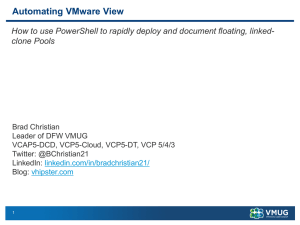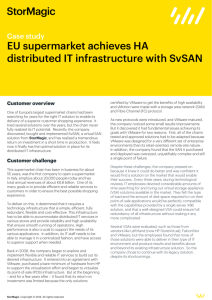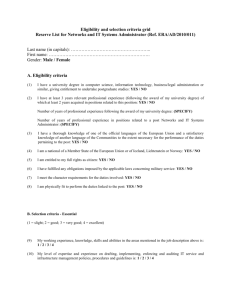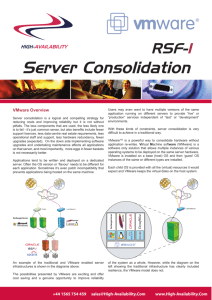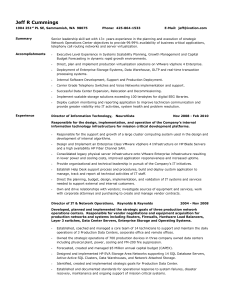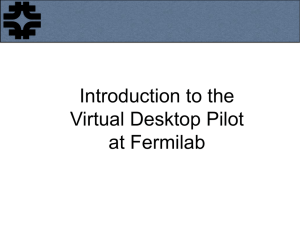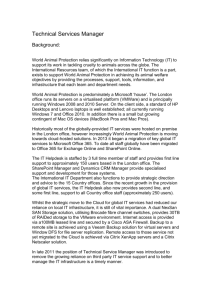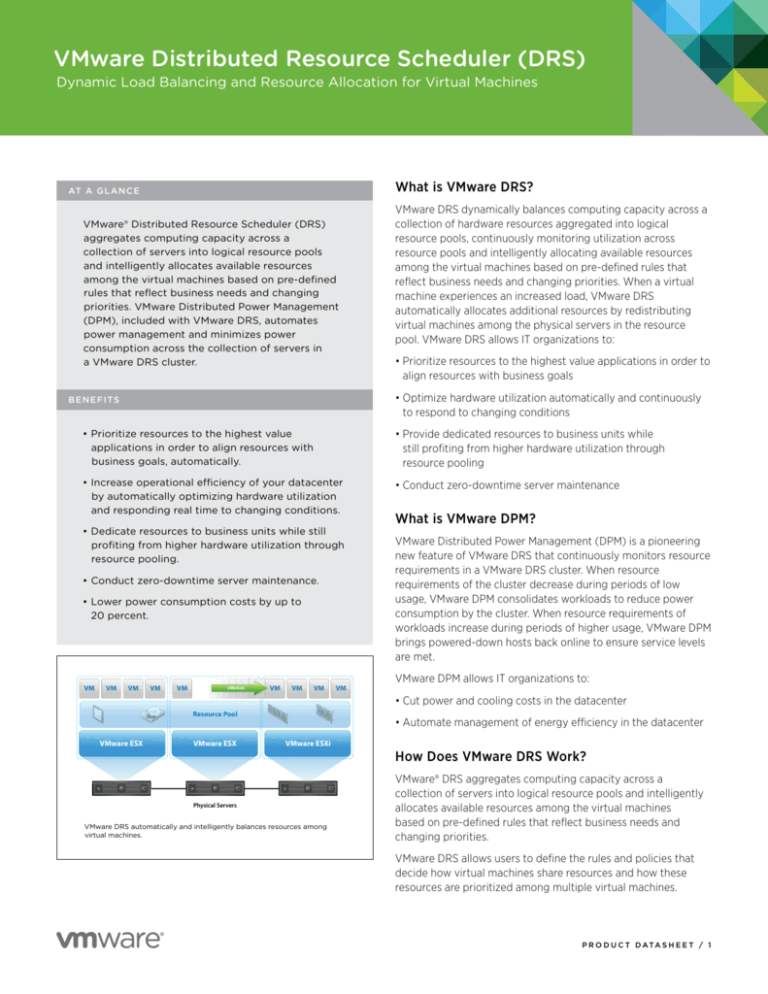
VMware Distributed Resource Scheduler (DRS)
Dynamic Load Balancing and Resource Allocation for Virtual Machines
What is VMware DRS?
AT A G L A N C E
VMware® Distributed Resource Scheduler (DRS)
aggregates computing capacity across a
collection of servers into logical resource pools
and intelligently allocates available resources
among the virtual machines based on pre-defined
rules that reflect business needs and changing
priorities. VMware Distributed Power Management
(DPM), included with VMware DRS, automates
power management and minimizes power
consumption across the collection of servers in
a VMware DRS cluster.
VMware DRS dynamically balances computing capacity across a
collection of hardware resources aggregated into logical
resource pools, continuously monitoring utilization across
resource pools and intelligently allocating available resources
among the virtual machines based on pre-defined rules that
reflect business needs and changing priorities. When a virtual
machine experiences an increased load, VMware DRS
automatically allocates additional resources by redistributing
virtual machines among the physical servers in the resource
pool. VMware DRS allows IT organizations to:
•Prioritize resources to the highest value applications in order to
align resources with business goals
•Optimize hardware utilization automatically and continuously
to respond to changing conditions
B E N E F I TS
•Prioritize resources to the highest value
applications in order to align resources with
business goals, automatically.
•Provide dedicated resources to business units while
still profiting from higher hardware utilization through
resource pooling
•Increase operational efficiency of your datacenter
by automatically optimizing hardware utilization
and responding real time to changing conditions.
•Conduct zero-downtime server maintenance
•Dedicate resources to business units while still
profiting from higher hardware utilization through
resource pooling.
•Conduct zero-downtime server maintenance.
•Lower power consumption costs by up to
20 percent.
VM
VM
VM
VM
VM
VM
VM
vMotion
VM
VM
VM
VM
What is VMware DPM?
VMware Distributed Power Management (DPM) is a pioneering
new feature of VMware DRS that continuously monitors resource
requirements in a VMware DRS cluster. When resource
requirements of the cluster decrease during periods of low
usage, VMware DPM consolidates workloads to reduce power
consumption by the cluster. When resource requirements of
workloads increase during periods of higher usage, VMware DPM
brings powered-down hosts back online to ensure service levels
are met.
VMware DPM allows IT organizations to:
•Cut power and cooling costs in the datacenter
Resource Pool
VMware ESX
VMware ESX
•Automate management of energy efficiency in the datacenter
VMware ESXi
Physical Servers
VMware DRS automatically and intelligently balances resources among
virtual machines.
How Does VMware DRS Work?
VMware® DRS aggregates computing capacity across a
collection of servers into logical resource pools and intelligently
allocates available resources among the virtual machines
based on pre-defined rules that reflect business needs and
changing priorities.
VMware DRS allows users to define the rules and policies that
decide how virtual machines share resources and how these
resources are prioritized among multiple virtual machines.
P R O D U C T D ATA S H E E T / 1
VMware DRS
When a virtual machine experiences increased load, VMware DRS
first evaluates its priority against the established resource
allocation rules and policies, and if justified, allocates additional
resources. Resources are allocated to the virtual machine by
either migrating it to another server with more available resources
or by making more “space” for it on the same server by migrating
other virtual machines to different servers. The live migration of
virtual machines to different physical servers is executed
completely transparent to end-users through VMware VMotion™.
VMware DRS can be configured to operate in either automatic or
manual mode. In automatic mode, VMware DRS determines the
best possible distribution of virtual machines among different
physical servers and automatically migrates virtual machines to
the most appropriate physical servers. In manual mode, VMware
DRS provides a recommendation for optimal placement of
virtual machines, and leaves it to the system administrator to
decide whether to make the change.
Flexible hierarchical organization of resource pools allows
administrators to match available IT resources to the needs of
the business organization. Individual business units can receive
dedicated IT resources while still benefiting from the efficiency
of resource pooling. Robust access privileges make it possible to
delegate routine infrastructure tasks for a business unit resource
pool to a business unit system administrator.
How Does VMware DPM Work?
VMware DPM is a component of VMware DRS that makes
recommendations or decisions to power off or power on hosts to
save energy. These recommendations are based on a comparison
of the available capacity in a DRS cluster against resource
requirements of virtual machines plus some administrator
defined buffer capacity requirements. If DPM detects there are
too many hosts powered on, it will consolidate virtual machines
onto fewer hosts and power off the remaining. VMware DPM will
bring powered off hosts online once again to meet virtual
machine requirements either at a pre-defined time or when it
senses virtual machine requirements increasing.
How is VMware DRS Used in the Enterprise?
Customers use VMware DRS to:
•Align IT resources with business priorities.
Define rules and policies to decide how resources should be
prioritized among virtual machines. VMware DRS dynamically
and intelligently allocates IT resources to the highest priority
virtual machines to ensure optimal alignment between
business and IT.
•Guarantee autonomy and service levels to business
organizations.
Provide dedicated resources to business units while
still profiting from higher hardware utilization through
resource pooling.
•Dramatically increase system administrator productivity.
Enable a single system administrator to monitor and effectively
manage a large pool of infrastructure resources.
•Automate hardware maintenance.
Place a physical server in maintenance mode and VMware DRS
will automatically migrate all virtual machines to other physical
servers, allowing server maintenance with zero downtime.
•Easily add and deploy new capacity.
Add new physical servers to a resource pool and VMware DRS
will automatically take advantage of the additional capacity by
redistributing virtual machines among the servers.
•Reduce power consumption in the datacenter automatically.
Consolidate workloads during off-peak hours and power
off hosts to make datacenters more energy efficient with
VMware DPM.
Key Features of VMware DRS
VM
VM
vMotion
VM
VM
VM
VM
VM
VM
VM
Resource Pool
VMware ESX
Standby Host Server
VMware ESX
VMware ESXi
Power Optimized Servers
VMware DPM automatically powers off physical servers to reduce power
consumption in datacenters.
VM
•Intelligent resource allocation.
Aggregate disparate hardware resources into unified logical
resource pools. With VMware DRS, resource pools are
automatically and intelligently optimized to ensure that
IT resource allocation matches business priorities while
maximizing hardware utilization.
•Flexible hierarchical organization.
Organize resource pools hierarchically to match available IT
resources to the business organization. VMware DRS ensures
that resource utilization is maximized while business units
retain control and autonomy of their infrastructure. Resource
pools can be flexibly added, removed, or reorganized as
business needs or organization change.
P R O D U C T D ATA S H E E T / 2
VMware DRS
•Isolation between resource pools.
Make allocation changes within a resource pool without
impacting other unrelated resource pools. For example, any
allocation changes in the resource pool dedicated to a given
business unit do not impact other resource pools.
•Power management.
Reduce energy consumption in the datacenter by using
VMware DPM to consolidate workloads and power off power
consuming servers. VMware DPM can be configured to make
recommendations for power on or power off based on
user-defined period of resource load history. For example,
power off decisions can be based on 1-2 hours worth of
resource load history and power on decisions can be based on
5-15 minute resource load history.
•Access control and delegation.
Secure resource allocation at different levels in the company
while eliminating bottlenecks. Virtual machine creation and
maintenance for a business unit can be delegated to a business
unit system administrator thus eliminating reliance on central IT
for every routine operation. Management of sets of virtual
machines running a distributed application. Optimize the
service level of distributed applications by controlling the
aggregate allocation of resources for the entire set of virtual
machines running the distributed application.
Find Out More
•Manual and automatic mode.
VMware DRS collects resource usage information from servers
and virtual machines, and then generates recommendations to
optimize virtual machine allocation. These recommendations
can be executed automatically or manually.
Product Specifications and System Requirements
VMware vCenter™ Server is required for setup and control of
VMware DRS and DPM.
•Initial placement.
When a virtual machine is first powered on, VMware DRS either
automatically places the virtual machine on the most appropriate physical server or makes a recommendation.
•Continuous optimization.
VMware DRS continuously optimizes resource allocations
based on defined resource allocation rules and resource
utilization. The resource allocation changes can be
automatically executed by performing live migration of virtual
machines through VMware VMotion. Alternatively, in manual
mode, VMware DRS provides execution recommendations for
system administrators.
How Can I Purchase VMware DRS?
VMware DRS is included with VMware vSphere™ Enterprise and
VMware vSphere Enterprise Plus Editions. For more information
on how to purchase, visit the VMware vSphere™ Web page at
http://www.vmware.com/go/vsphere/buy.
For information or to purchase VMware products, call 1-8774VMWARE (outside of North America dial +1-650-427-5000),
visit www.vmware.com/products, or search online for an
authorized reseller. For detailed product specifications and
systems requirements, please refer to the VMware VMotion
install and configure guide.
•Maintenance mode for servers.
Perform maintenance on physical servers without disruption
to virtual machines and end users. When a physical server is
placed in maintenance mode, VMware DRS identifies
alternative servers where the virtual machines can run.
Based on automation mode settings, the virtual machines
are either automatically moved to use the alternative servers,
or the system administrator performs the move manually using
the VMware DRS recommendations as a guideline.
•Affinity rules.
Create rules that govern the allocation of virtual machines to
physical servers. For example, certain virtual machines can
always run on the same server for performance reasons.
Alternatively, specified virtual machines can always run on
different servers for increased availability.
VMware, Inc. 3401 Hillview Avenue Palo Alto CA 94304 USA Tel 877-486-9273 Fax 650-427-5001 www.vmware.com
Copyright © 2009 VMware, Inc. All rights reserved. This product is protected by U.S. and international copyright and intellectual property laws. VMware products are covered by one or more patents listed at
http://www.vmware.com/go/patents. VMware is a registered trademark or trademark of VMware, Inc. in the United States and/or other jurisdictions. All other marks and names mentioned herein may be
trademarks of their respective companies. Item No: VMW_09Q3_DS_DRS_USLET_EN_P3_R3

